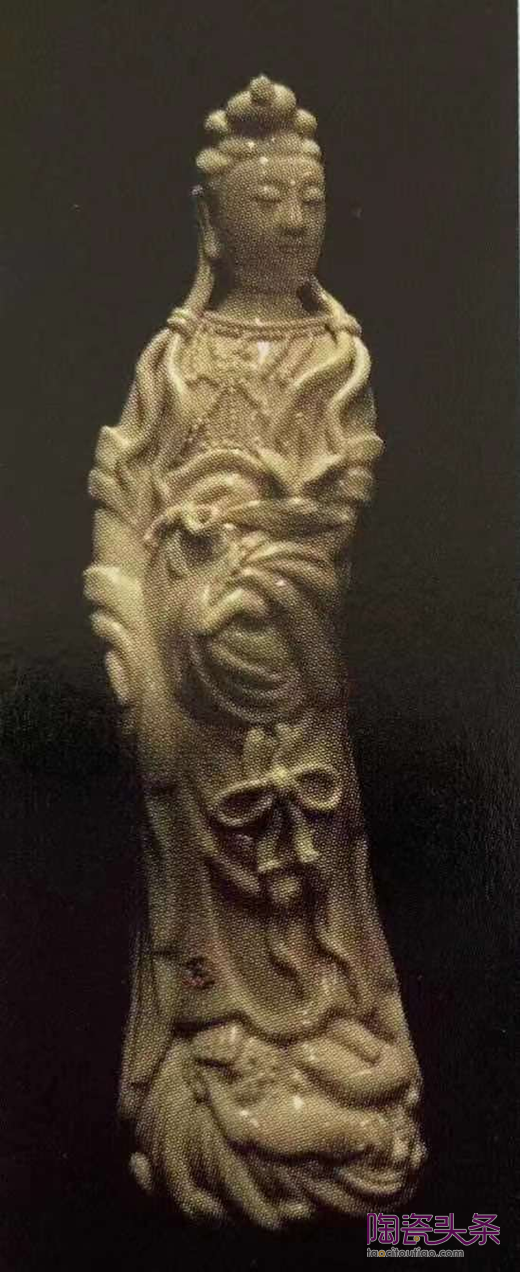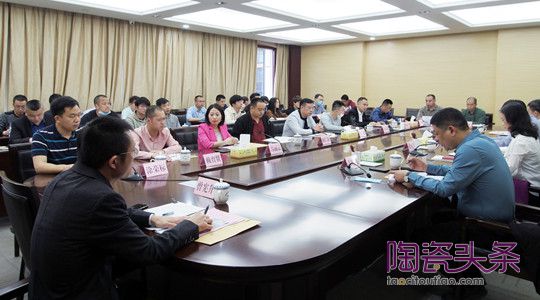外国人眼中的“中国白”5(连载)

-
小陶陶
2021-07-28 14:29:08 德化陶瓷文化研究院、陶瓷办1856
10870
编者按:由柯玫瑰(Rose Kerr)、约翰•盖尔(John Ayers)所著《——德化白瓷》(Blanc de Chine—porcelain from Dehua)于2002年经新加坡亚洲文明博物馆出版,是继唐纳利《——福建德化瓷》之后的一本专门研究德化白瓷的专著,影响甚为深远。
该书收录的都为国外研究德化白瓷的知名学者所撰写德化白瓷研究资料。包括柯玫瑰的“德化器物款识介绍”,海蒂(Heidi Tan)的“鉴赏家探访”,约翰•盖尔的“的影响”,何翠媚(Chuimei Ho)的“考古眼光中的”,郭勒逊(Kenson Kwok)的“德化雕塑结构的一点看法”, 埃娃•施特勒伯(Eva Strober)的“德累斯顿的斯特朗大帝收藏的德化瓷”,以及附录介绍等七个部分,从不同角度介绍了德化白瓷。与此同时,该书收录的160件德化窑精品,为Hickley家藏,后捐赠给新加坡亚洲文明博物馆,是了解、品鉴、研究德化白瓷不可多得的艺术精品。
本栏目将定期精选出相关代表性文章进行翻译,以飨读者。然而,由于作者水平的局限,翻译过程中难免有所错漏,不足之处敬请各位读者提出宝贵意见。
Blanc de chine: some reflections by John Ayers 的影响(五)——约翰 盖尔(翻译:德化陶瓷文化研究院 孙延燕)
A tall standing Guanyin from the same exhibition also has the He Chaozong mark (Fig. 22). It is another monumental piece, over 20 inches tall and shows the white-robed and mantled deity standing on a rock lapped by the sea. One foot is revealed but the hands are hidden, clasped under the long sleeves of the robe which is lightly blown by the breeze. In some respects the model is even more impressive sculpturally than that of Wenchang and it is certainly more complex in treatment-in the indication of the hair and head-dress for instance, or in the finely etched waves.
在同一个展览中的一个高大的观音立像也有何朝宗的标记(图22)。这是另一件具有纪念意义的作品,观音超过20英寸高,穿着白袍和披着斗篷站在海边的岩石上。一只脚露了出来,但是双手却藏了起来,紧扣在被微风轻轻吹动的长袍的长袖里。在某些方面,这个瓷塑在雕刻上甚至比文昌的模型更加令人印象深刻,而且在处理上也肯定更加复杂——比如头发和头饰,或者精致的波浪。

(Figure 22. Guanyin standing on clouds. Height 45. 1 cm. Dated 1681. Bluett & Sons.)
(图22: 祥云观音。身高45.1厘米。1681年,布鲁特家族。)
The porcelain lacks the creamy colour of that model, and all in all it is tempting to suggest it was made a decade or two later.
瓷器没有那个瓷塑的奶油色,总而言之,它很容易让人联想到它是10年或20年后制作的。
Figures of such presence and material perfection were not necessarily made over a very long period; and while a certain number of such superior pieces are to be found, the predominance of poorer ones is admittedly depressing. The British Museum exhibition performed a valuable service in showing a selection of those for which, I think, Donnelly sometimes entertained rather too much respect In Figure 23, for instance, is a figure bear ing the mark'he Chaochun. Donnelly describes He Chaochun as being"possibly a younger brother of He Chaozong, and suggests a period of activity around 1700. But for my money these simpering inventions bear only a remote relation- ship to the kind of work we have just seen: the conception is trivial and banal while the actual modelling, not to mention the finishing, is of a crudity one has difficulty in associat- ng with the eighteenth century.
瓷塑的这种呈现方式和材料上的完美并不一定是在很长一段时间内完成的; 虽然可以找到一定数量的这种优秀作品,但是拙劣作品的主导地位确实令人沮丧。大英博物馆的展览提供了一个有价值的服务展示了那些我认为,唐纳利有时戏谑但非常尊重的作品,例如图23是一个标记着“何朝春”的瓷塑。唐纳利形容何朝春可能是何朝宗的弟弟,并暗示他在1700年前后有过一段活动。但是在我看来,这些愚蠢的发现与我们刚才看到的那种作品只有很小的关系: 概念是琐碎而平庸的,而实际的瓷塑,更不用说是完整的,是一种粗糙的东西,很难与18世纪联系起来。

(Figure 23: Slip-cast model with mark of He Chaochun. Height 26.7cm. Early 20 century. British museum.)
(图23: 带有何超春印款的注浆瓷塑。身高26.7厘米。20世纪初。大英博物馆。)
In this lecture I have tried to show some of the ways in which fresh information obliges us to reassess our former views about Dehua porcelain in the West. I have argued, firstly, for he view that Dehua products should be seen as representing a continuous tradition stretching pack to Song times, even if parts of the Ming development are still highly obscure. I have indicated, too, from the pre-existing evidence, supplemented by that of Hatcher and others, chat the flowering of blanc de Chine in the seventeenth century, both at home and for export, certainly occurred earlier than Donnelly thought and may also have been shorter lived than he assumed And given this somewhat firmer ground, I would suggest there is a need to reconsider the dating and grouping of blanc de Chine figures, not to mention other wares, after the seventeenth century in a fairly drastic way. That, however, is too big a topic to become involved in here. Perhaps the most striking outcome of these reflections lies in the realization of just how much of the best of Dehua may date from the first, or predominantly Ming portion of the seventeenth century: bearing out the surprising extent to which those Chinese commentators who have always so argued may, despite Western disbelief. have been right all the time.
在这次报告中,我试图展示一些方式信息因为新信息的涌入促使我们重新评估我们以前西方对德化瓷器的看法。我认为,首先,他认为德化产品应该被视为代表一个延伸至宋代的持续性的传统,即使部分明代发展仍然高度模糊。我也从已经存在的证据,加上哈彻号和其他人的证据,谈到17世纪瓷器的繁荣,无论是在国内还是出口,肯定比唐纳利想象的要早,也可能比他想象的要短,而且考虑到这个更坚实的基础,我建议有必要重新考虑瓷塑的断代和分类,更不用说其他产品了,在17世纪之后,以一种相当戏剧的方式出现。但是,这么做太过分了,不能牵扯进来。也许最引人注目的结果在于德化陶瓷精品可以追溯到17世纪的最初,或者说主要是明朝时期: 令人惊讶地证明了那些一直被中国评论家们争论的结论,尽管西方人不相信,一直都是正确的。
John Ayers was formerly Keeper of the Far Eastern Department, Victoria and Albert Museum, and is now an independent scholar. This essay was first published in Transactions of the Oriental Ceramic Society, Vol. 51, 1986-87, and is reprinted by permission of the Oriental Ceramic Society, London。
约翰·盖尔曾是维多利亚和阿尔伯特博物馆远东部的管理人,现在是一名独立学者。这篇文章首次发表在《东方陶瓷学会》汇刊上,1986-1987年51卷,并经伦敦东方陶瓷协会批准重印。
来源:德化陶瓷文化研究院、陶瓷办
责任编辑:陈美珠
















